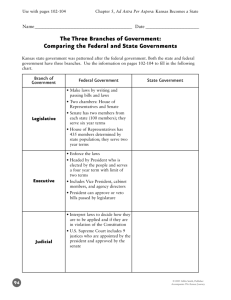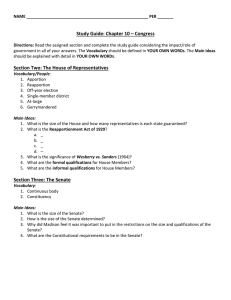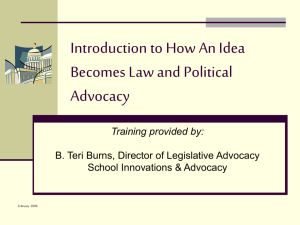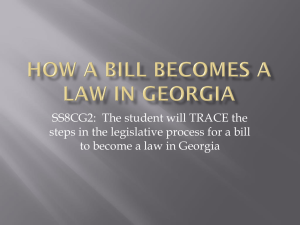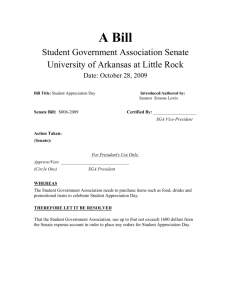Legislative & Media Advocacy - Commonwealth Prevention Alliance
advertisement
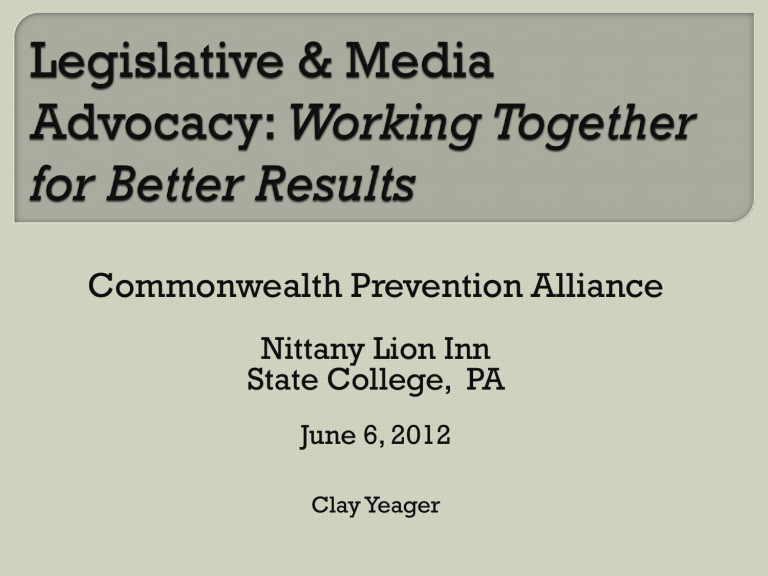
Commonwealth Prevention Alliance Nittany Lion Inn State College, PA June 6, 2012 Clay Yeager How to Become a Great Advocate (When Good Isn’t Good Enough) How the Legislative Process Works How a Bill Becomes a Law Tools for Connecting to your Legislator Effective Communications Strategies for Engaging the Media Skills and Qualities Necessary Knowledge of the Legislative Process Knowledge of the Issue(s) Personal commitment to the Issue(s) What are YOUR expectations in becoming involved in advocacy? What do you want to accomplish? What are the biggest barriers to getting involved? How have you already engaged in advocacy? 1st 1st - Prison Built in US (Eastern State Penitentiary) – Highest Rate of Juveniles in Out-of-home Placement Among 10 Most Populated States (OJJDP, daily census) – Among 10 Most Populated with INCREASED out-of-home placements between 2001 and 2010 (OJJDP, daily census) 1st – Number of Juveniles Sentenced to ‘life without parole’ (Human Rights Watch) 1st – Largest increase in new inmates to state corrections (Pew Center, 2009) 1st $ 2 Billion – 2011/12 Budget for State Corrections System Million – Services to Delinquent Youth in PA. $500 1.3 Million – proposed 2012/13 Budget for Evidence-Based Prevention and Intervention Programs $ About 60-75% of adult inmates have juvenile records $2 BILLION is 2,000 MILLIONS DAILY cost of prisons is $5.4 MILLION DAILY cost of evidence-based prevention is $5 THOUSAND More $ is spent between 6:00 am and 3:00 pm in ONE DAY housing 52,000 inmates than is spent during AN ENTIRE YEAR on proven programs designed to keep prevent them from entering Incarceration Rate - Pennsylvania 1980-2010 (number of inmates per 100,000 residents) 1980 1990 2000 2010 69 per 100,000 188 per 100,000 299 per 100,000 405 per 100,000 If the same rates of incarceration from 1980 were applied to the 2010 state population, the current prison population would about 8,764 inmates In states, it would rank #2 behind public education At federal level, it would rank #6 – behind social security, national defense, income security, Medicare and Medicaid Federal and state governments spend 60 times more to clean up devastation of drug abuse and addiction on children as they do on prevention and treatment Y.F.C. # 2 $142,715.00 Y.F.C. # 3 $156,220.00 Y.D.C. @ Loysville $162,060.00 Y.D.C. @ Cresson $180,310.00 North Central Secure $189,070.00 Y.D.C. @ New Castle $198,925.00 South Mountain Secure $213,890.00 $177,598.00 average annual cost per youth YOUR county places 6 juvenile offenders in state operated facilities Annual Price tag $1,065,588.00 (for 6 kids) Program Number Served Multidimensional Treatment Foster Care 60+ youths in care for seven months 100+ families enrolled for THREE Years 340+ families taught the curriculum series 1,000+ high risk children matched 5,100+ schools trained P.A.T.H.S. 33,000+ elementary school students taught social and emotional regulation 142,000+ students taught peer resistance and conflict resolution skills ‘People who love law and good sausage should never watch either being made’ German Chancellor Otto von Bismark 1815-1898 Legislature – Two Bodies (Chambers): House and Senate Bi-Cameral – 50 members elected for 4-year terms; headed by Senate President Pro Tempore Senate – 203 members elected for 2-year terms; headed by Speaker of the House House Republicans control the House, the Senate and the Governor’s Office 30 Republicans in Senate 112 Republicans in House 20 Democrats in Senate 91 Democrats in House is the 2nd largest legislature in the country (behind New Hampshire) Pennsylvania Each legislator represents about 60,000 residents Pennsylvania is the largest ‘full-time’ legislature in the country Members are paid $79,613 annually plus per diems while in session Coalition (def.): ‘an organization of organizations’ working together to affect change on similar issues or concerns’. Advocates build coalitions to build the power necessary to do something not able to be done by one group alone Advocacy with legislators is about persuading them to do what you want. The first step is building a strong relationship with them and their staff. You need to earn and nurture their respect Be prepared, know the subject, do not overload them and stick to the issue(s) Respect their time restraints – summarize clearly Research other issues they are involved with Present both sides so they can anticipate the opposition Compliment them on anything – a little ‘thank-you’ goes a long way Get to know their aides – they are a key to access Provide positive public and media opportunities through awards programs, ‘photo ops’, annual meetings – anything to get them noticed Honor them – give them public recognition with a special award Remember their birthdays and other milestones – send a handwritten note Only provide them with useful information – facts, data, outcomes, cost savings The most important thing to remember is that elected officials are just like everyone else. They appreciate people who show an understanding and respect for the individual legislator’s personal philosophy and issues and they take note of coalitions that have a clear strategic vision. Confront, badger Take or challenge up too much of their time – respect theirs Lecture them – instead a provide clear, concise message to leave with them Threaten Become them with negative consequences a Jack Abramoff Letter Writing/e-mail Telephone Face-to-face Public meetings Hearings Testimony Be clear about what you want Letters should be less then one page Be precise about what you want – get right to the point Only address one issue at a time Send letters only when it’s necessary Trying to initially drum up support for an issue A vote on a bill of importance is looming The legislator has done something advocates want to praise The legislator is undecided about an issue Be very clear about the issue and what action you want them to take Address the letter properly (see guidelines) Personalize the issue. Tell them how the issue impacts you, outcomes for youth and families, cost impact Do not ramble Thank them for their attention – ask for a written response and their position Include your full name and address to assure them you are a constituent While nothing is better than a face-to-face meeting, calling assures that someone will answer If the member is not available, it is equally important to convey the message on the issue to the appropriate staff person, e.g. policy director Prepare your message before you call Identify yourself as a constituent Say exactly what you are calling about – use bill numbers or issues State specifically what you would like your legislator to do Leave your name and contact information their capitol office – has more impact. During recess, call their local office Do not criticize or debate The call will likely be about 2 minutes – critical to get your message across If unable to speak directly to member, staffers have the ear of the boss Conclude by thanking legislator or their staff for their time and attention Call Every citizen has the right to seek a meeting with their elected officials A face-to-face meeting is the most effective way to get your message across You can meet several in the Capitol and also in your home district Make appointments as far in advance as possible Dress professionally Arrive early and be prepared to wait Keep the group small Choose a spokesperson – preferably a key, visible leader or someone with a personal connection Ensure the group is diverse; able to address issue from multiple sides Be informal, but not disrespectful Do not use jargon or acronyms (CTC, SPIF-SIG, PCCD, DPW, EPIS, D&A, ODAP,) they do not speak your language Learn in advance with whom you are meeting; if staff member, it’s okay as they convey message to member Be specific about what you are asking of the legislator; (cite bill # or line item) Be prepared to answer questions Bring packets of information to leave, include brief synopsis of issue – one sheet fact sheets are best Make yourself available to the legislator as ‘experts’ on these issues Follow-up; send thank-you letter immediately, along with your contact information Generally, public hearings are held after a bill has been introduced and assigned to a committee in either the House or Senate Hearings are held to give individuals and groups the opportunity to interact and exchange information and to seek comments regarding a proposed bill A chance to tell your story (10 minutes or less) Provide facts and data – Legislators want hard data, costs, numbers, research, outcomes and impact Start by introducing yourself, the group you represent, the bill # or issue Be brief and precise – avoid lengthy clichés or philosophizing Use personal (and local) examples to prove your points Do not make claims you are not prepared to defend Prepare a written copy of your testimony to leave with committee members, staff, the media and other attendees End by thanking the committee and legislator for the opportunity Any member of House or Senate can introduce a bill After introduction, measure assigned a # and referred to committee Bills introduced in House are assigned to House committee; in Senate to Senate committee Committee Chair (majority party) decides what bills move forward Bills before committee are reviewed and debated Committee may hold hearings and solicit testimony Not every bill gets a vote – 4 possible outcomes Committee approves and sent to full House or Senate for consideration Bill amended and sent to full House or Senate for consideration Bill tabled rendering it inactive Bill voted down or never reported out of committee, nullifying it Approved bills go immediately to respective Appropriations committee A ‘fiscal note’ or detailed financial impact is included Bills can meet any of same 4 outcomes After committee approval, House or Senate considers bill MUST be considered on three separate days before voting 1st Day – bill is read on the floor to report as original or amended; no amendments, no debate, no votes 2nd and 3rd Days – Amendments made, debate offered All legislators present must vote on bill – no abstentions or proxies allowed Bill passed or rejected Bill approved in House or Senate, must go through identical process in the other chamber Example – if a House bill is approved by full chamber is then moved to Senate Referred to appropriate Senate committee, then to Appropriations committee for fiscal note If Senate changes bill, it must go back to House for concurrence to Senate changes Identical versions of bill must be passed by House and Senate Bills approved by both chambers then sent to Governor for signature – Assigned ‘Act #” The process can take months Bills not enacted during 2-year session MUST be reintroduced If not enacted, must begin the process again Issuance of Budget Instructions & PPG’s August-Sept. New Fiscal Year Begins July 1st Legislative Review & Budget Enactment February-June 30th Governor’s Office & Budget Office Review November-January Governor Budget Address to General Assembly - February The primary purpose of working with the media is to influence public attitudes about the same issues you advocate. Public opinion is a powerful tool in advancing the issues to coverage – develop and nurture relationships with reporters Become an expert resource – Reporters need story ideas, so help them develop stories about your issue Read, watch, listen – Get to know the local media reporters for each ‘beat’ – crime and justice, education, health, public policy, government Respond the local media – you can make their job easier Cultivate Advisory – announcing an upcoming event or announcement News Release – Provides more detailed information about an issue News activities – meetings, forums, announcements, reports with media in mind Plan IF media responds, inform policy officials, legislators and key leaders aware Create opportunity to highlight policy makers in front of media Develop an always ready media (press) kit handy, including: Cover letter Press release – who, what, where, when and why Fact sheet – one sheet Brochures Relevant materials, i.e. third party testimonials, research findings, impact on outcomes and costs Board meetings – most will print editorials on selected issues News stories – cultivate relationships with editors and contacts Features – photos and in-depth information Letters to the Editor – be direct, distilling issue, cite examples; signed with title, address and contact information Editorial ‘Never get into an argument with someone who makes ink by the barrel’ – you will lose Never be condescending or dismissive Never say ‘no comment’ Never neglect to follow-up if you said you would Never lie or misstate information Goals Organizational Constituency Long Term What resources can you put in? Who cares about this issue? Intermediat e Short Term How will you organize? What internal problems might you experience along the way? Targets Who has the influence to give you what you want? How are others Who are organized? your secondary targets? What power do they have? Tactics Press releases Letter writing Visits Capitol Day Meet with legislators Letters to the editor media "In all forms of government the people is the true legislator.” Edmund Burke www.pa.gov agencies - for a complete list of state www.legis.state.pa.us - for a complete listing of all members of the Pennsylvania House and Senate, committee assignments and contact information www.budget.state.pa.us - for a detailed description of the budget process and annual timelines for submission Pennsylvania 717.236.6984 Legislative Services – Special Edition - Preventing the Big Five Teen Pregnancy – Drug Abuse – Delinquency – Violence – School Dropout Pennsylvania Reduces Out-ofHome Placement and Costs at Record Rate Credit Goes to Commonwealth Prevention Alloance June 2014 PREVENTION PROGRAMS Blueprints for Violence Prevention SPECIAL EDITION I I I I I I I I I I I I I Doing it Right – Model Fidelity Complete Cost Benefit Analysis, p.16 I I Thank-you for your time and attention today Please feel free to contact me: Clay Yeager 717.870.2144 cryeager@comcast.net


